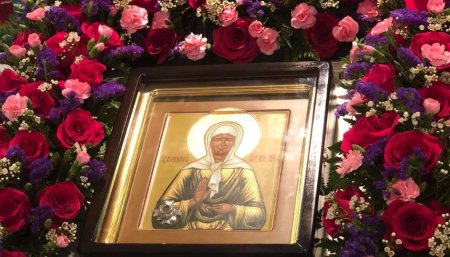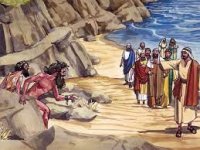Service Schedule. 21st Sunday - The Gadarene Demoniac in Context
 Great joy for us!
Great joy for us!Visit of the great shrine to our Church!
Blessed Matrona of Moscow, pray to God for us!
On November 14, in our Church of St. Luke of Crimea in the city of Pompano Beach, an icon with a particle of the holy relics of the Blessed Matrona of Moscow will be brought for worship.
Service Schedule:
At 8 am - Meeting of the Icon and Confession,
at 10 am - Divine Liturgy, a prayer service at the Icon and Coffee hour.
Великая радость для нас!
Визит великой святыни в наш Храм!
Блаженная Матрона Московская, моли Бога о нас!
14 ноября, в наш Храм Святителя Луки Крымского в городе Помпано Бич, будет привезена на поклонение икона с частицей святых мощей Блаженной Матроны Московской.
Расписание Богослужения:
В 8 утра- Встреча Иконы и Исповедь,
в 10 утра-Божественная Литургия, молебен у Иконы и Чаепитие.
 The Gadarene Demoniac in Context.
The Gadarene Demoniac in Context.
The Reading from the Holy Gospel according to St. Luke. (8:26-39)
I would like to begin my sermon this morning with a perfect quote from Hafiz to set us on the right path. "I wish I could show you when you are lonely or in darkness the astonishing light of your own being." I think that is what Jesus did for everyone he met, even to those who rejected him.
Every person and situation Jesus met in the Gospels was unique and merited the Lord’s undivided attention and he gave it. I always wonder about the details scripture leaves out. What happened between the Gadarene man after his healing while the herdsmen were rushing after their pigs? The distance between the city and the lake was pretty substantial! How much time elapsed before the townspeople came to see that had happened? All we know is that when they arrived he was dressed sitting at the feet of the Lord and “in his right mind.” That last detail is by far the most important one.
Think of this man’s terrible, prolonged suffering. He had been stigmatized as a man possessed. “Demon-possessed” had become his self and his social identity. He lived in poverty among the tombs, without clothing and often shackled in chains. His psychotic behavior was frightening and explainable in those demon-obsessed days in only one way: he must have been invaded by external, demonic forces. As we know many diseases were attributed to demons in the ancient world, particularly those no one knew what to do about. Who then knew how to treat madness?
So, we must read this story in the light of the times. In fact, all literature must be read with a view of the historical and cultural context or we miss the meaning intended by the author. In first century Palestine we have a cultural milieu that was like a thick soup filled with ingredients from all over the Roman Empire and beyond. The Silk Road ran right through Palestine bringing people with their varying perspectives, including religions and philosophies right through Judea and beyond. We know that the time of exile in Babylon affected the practice of Judaism significantly. It was only after that period that Judaism took the demonology so seriously. In the Old Testament there are hints of it, but not much else.
If you look into the context of today’s reading you find some surprising things. Here is an example from ancient myth and astronomy. In the night sky the ancients saw constellations as we do, but with different names than we have. Three of them were called the Mad Dog, the Pig and the Abyss. They were in close conjunction with each other. One of the myths had something to do with the abyss constellation chasing the pig constellation with a view to devour it. It is interesting that we see this scenario played out in today’s Gospel. Madman (mad dog), swine (the pig) and the demons’ fear of being cast into the abyss. Almost certainly some of the Gadarenes who were not Jews could make the connection. They may well have heard stories about the three as children. The early church saw Jesus as the end of all religion and the one who gave meaning in his person and ministry to all the myths and beliefs of humanity entire. We have seen this already in the first icon of the Nativity of Christ if you recall with animal representations of Egyptian gods and the Wide Men coming over the hill in the vestments of Mithraic priests. They all gathered at the manger where God was incarnate to offer worship.
The Lord in his cultural, historical context did today what needed to be done and in the way it needed to be done to heal the man and quell the fear surrounding him. In context exorcism was completely reasonable. Who, including the man and his community, would have believed he was healed without an exorcism especially since the stigma of possession had become his very identity? Jesus not only needed to cure the disease, he needed to remove the stigma and so, as is always the case, the healing of this man began in him and extended to everyone who knew him like ripples in a pond in a way that could be grasped by them all. As we read in the Talmud, “Save one life and you save the world entire.” Every healing is always both personal and cosmic in nature. Even though the townspeople could not embrace Jesus at that time, the seeds of healing were planted and more than likely would take root later when conditions were right. As Bishop JOHN is often heard to say to me since I need to hear it, “Fr. Antony, I’m afraid everything is going to be alright.”
Now, I confess, I have never met a person I had reason to think was possessed. A young man once approached me in California as I wandered through the frozen food section of a supermarket and asked for an exorcism. After hearing his story, I perceived that he was simply afraid and in need of some good therapy. I also knew a woman who suffered from multiple personality disorder and would call me now and then as a different personality. Once as a jaguar! Demon possession, even in my young days as a priest, didn’t seriously cross my mind. She was in a great hospital, receiving the best of care and making progress. Gradually, the phone calls as difference personalities ended.
But I have met many suffering people, dying people, people with terrible diseases both of the body and of the mind. Some of them come for help and with spiritual counsel and spiritual practice, including prayer, meditation, mindfulness and the use of psychological tools from mindfulness-based therapies, I have seen some miraculous things happen.
I work in a prison on Monday nights where you would expect hopelessness and despair and a whole plethora of psychological distress. Last week, as we read from Metropolitan KALLISTOS Ware’s book, THE INNER KINGDOM, I heard a significant number of men speak about their regular and on-going spiritual practice. It seems that MCI Concord is honey-combed with cells peopled by men who meditate, pray and study Holy Scripture daily and regularly. We are privileged to work with them and learn from and with them as we journey the spiritual road together. I go there not to teach but to share in fellowship with a group of men who are working out their salvation in “fear and trembling” and with joy.
God is light. Jesus is the light of the world. He even called us the light of the world. He came to show us this light both inside ourselves and outside ourselves. Our job is to do as he did, to be the light, to share the light, to let others know that this light is also in them, especially when they are lonely or in darkness. That is where our focus should be, not on demons, or darkness, or sin, but on God, on the light and on holiness. What we seek for we shall most certainly find.
 The Gadarene Demoniac in Context.
The Gadarene Demoniac in Context.